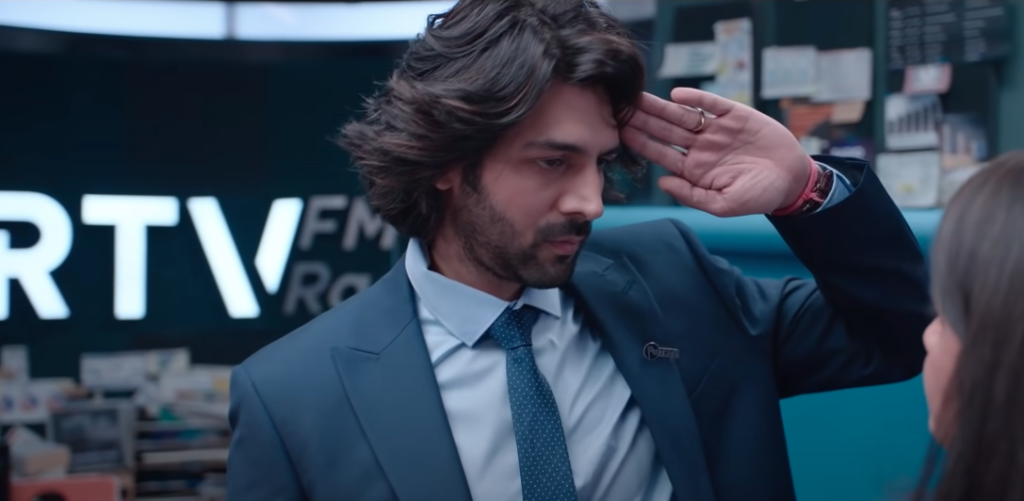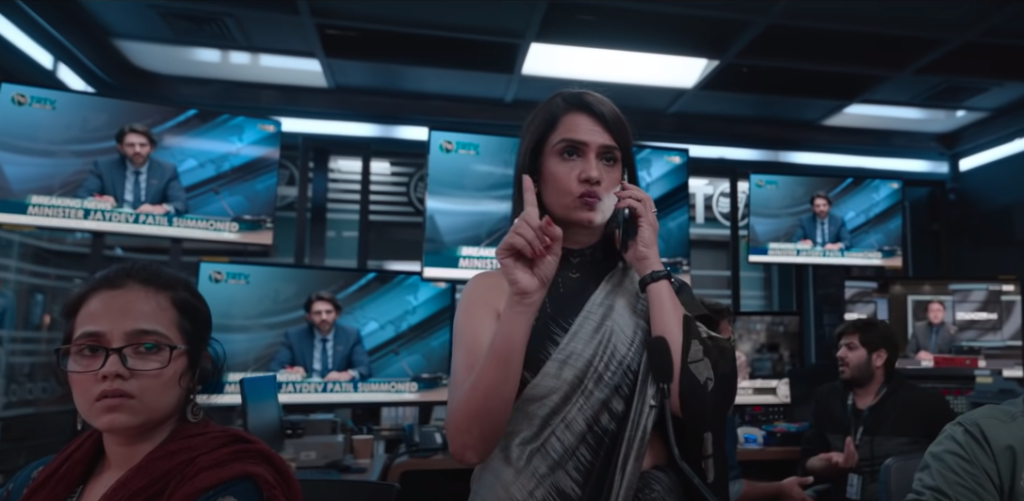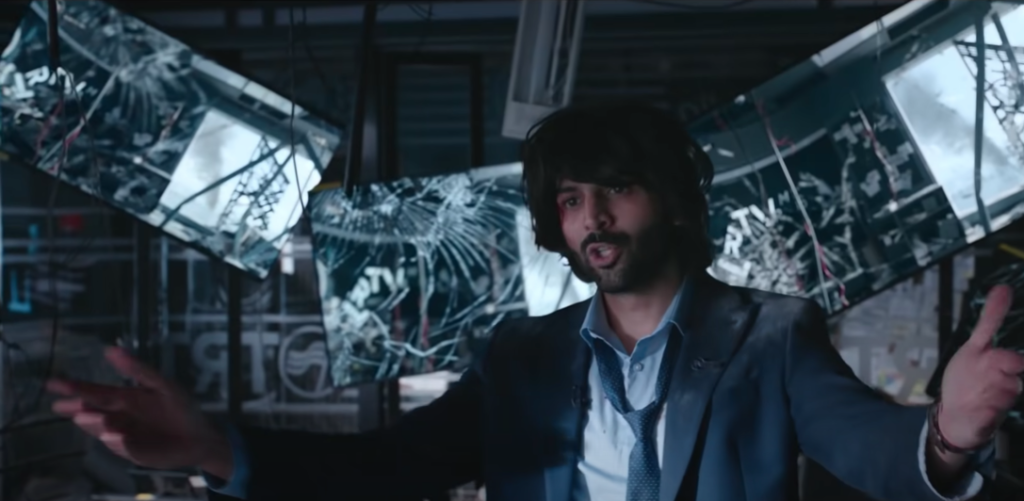- Anchor kya hai?
- Actor.
- Actor kya chahta hai?
- Audience.
- Audience kya chahti hai?
- Drama.
A flimsy prep talk just before a disaster sequence in the story. Fictional frontiers pushed way too far, in the lieu of creative liberty.
Anybody who’s worked in some form of the communications industry must’ve received the “tum media wale” jibe at some point of their career or run.
A generalised and scandalous view of the media division of this industry formed by stooge newsmen serving advertisers, corporates and establishments. A typecast draped around the faltering fourth pillar of our democratic setup.
Like any other discussion, this too has three sides. One, who have given up on the news media, the ones who don’t care. And the ones who still rally for it.
Dhamaka belongs to the third bracket. A belief system that wishes to find a silver lining amidst the clouds of dipping credibility. And in the vigil, becomes an appeasement derby.

The protagonist Arjun Pathak is a staple Hindi film metropolitan character equipped with tropes of a failing relationship, trembling career path and contemplative virtues. The film appears fresh till it doesn’t step into designated territory. That is the first 7 minutes.
Once the narrative gets into the conflict, the generic writing starts crumbling. Explosion at Bandra Worli Sea Link, a mysterious antagonist once wronged by the corrupt system and a whodunnit realm wrapped around the story. A chunk that we were briefed about in the trailer.
The next 20 minutes of this just above 100 minute film are an unpacking of that.
Slick aesthetics, immersive visuals and pounding BGM don’t cover-up Kartik Aaryan’s depth vacuum. He’s visibly a highly mannerised actor, trained by either bad coaches or the 90s flair of acting that doesn’t rise the cake anymore. Not saying that acting flair is bad but it’s suited to that era’s communication.
Aaryan’s fix is quite alike his seniors Shah Rukh Khan and Amitabh Bachchan. It’s not the star playing the character. It’s the character playing the star. A roadblock that could’ve been averted if the written material offered some weight to the actor. But the screenwriting is the bedrock of this punctured film.
Everything in Dhamaka is an exposition relay.
An appraisal and rating feasting boss, a dutiful yet stoic cop, two lovers who work in the same organisation and a swerve stitched beneath the protagonist to serve as a swerve midway. The film conveniently put blinkers on for audience curiosity. How did the antagonist get access to their office microphone? How can a labourer turn tech savvy enough to take a city under siege in a span of two years? And most importantly, which boss reminds her or his subordinate about ratings amidst crisis; an otherwise key objective of your occupation placed in your semantic memory and subconscious? We soon realise why.

As the unravelled is touched and the story unfolds, all these tropes make sense. The dots connect. The aim isn’t to tell a compelling story. It’s to offer an apology to the audience and redeem the disparaged and neglected news media industry. The characters don’t reciprocate to the universe of the telling. They preach. They dissuade sensationalism, in a sensationalised story itself.
The film doesn’t address its own setting but attempts universal lecturing. Hence, the lack of involvement leads to lack of emotional investment from this end. Losses don’t ache the heart. Character grief doesn’t resonate across.
The core of this film wasn’t bad or impure. The idea stems from the plight of unskilled labour in our country since time immemorial. From a time when the commoners were called cattle class to when they’ve been called traitors, extremists and what not, the germination stage thought of this film could’ve done wonders for a work of fiction.
Look back at the famous Angry Young Man brand from the 70s. It gave us the industry’s biggest superstar for that thought hit home with the audience. Reference to context, the idea of placing a labourer working for the Sea Link project had endless possibilities as a story idea. But this film is a remake of Terror Live and reliance on source material tends to deflect the story from socio-cultural and geopolitical contextualisation. What could’ve uncoiled as a solid telling of class divide, imploded and ended up being the overdone-still not perfected media madar**** hai diatribe.
If a dog bites a man, it’s not news. If a man bites a dog, it’s news. A flawed definition of journalism professed by bad lecturers to trainees of ineffective media institutes. The film fails because the root idea of journalism has been taught wrong. It was never about news. It was about communicating information. Which gradually got foiled by advertising. A thought beautifully captured in RGV’s Rann, where the protagonist simply quips, “Pehle khabar lakshya hota tha aur paisa madhyam. Ab paisa lakshya hai aur khabrein madhyam”.

This one-dimensional, jaded, image cleansing film doesn’t possess the holistic view and maturity to pierce into that dynamic of the news media matrix. For its easier to preach than practice.
Still, the whole ordeal seemed passable courtesy the runtime and home-viewing convenience of the offering. Then occurred the climax, where for no apparent reason, the film enters a James Bond-meets-Bourne Identity trajectory.
By now, the makers have forgotten what the film was about and aim to create some food for thought with a collision of Arjun Pathak’s seeking and regrets, conniving colleagues and a gullible society. But too late. The scaffolding by now had already cracked. The anticipated sting never rose above mosquito bite intensity. The live feed between the excited audience and a half-baked film was now cut off.
Too much noise, yet no voices. Too many sentiments, yet no feelings.
Dhamaka fizzles away. All smoke and no fire.
Dhamaka is now streaming on Netflix.